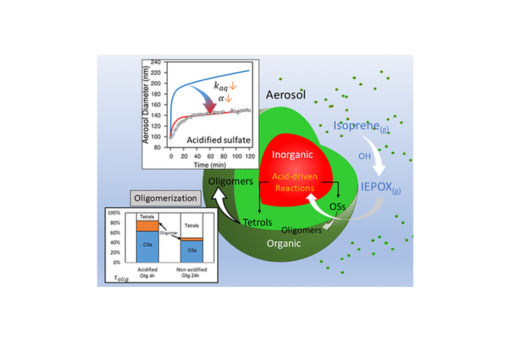Observationally Constrained Modeling of the Reactive Uptake of Isoprene-Derived Epoxydiols under Elevated Relative Humidity and Varying Acidity of Seed Aerosol Conditions
Abstract
Isoprene is the nonmethane volatile organic compound (VOC) emitted in the largest amounts to the atmosphere, and it is a significant source of secondary organic aerosol (SOA) mass. The uptake of isoprene oxidation products followed by multiphase chemistry in fine particles is the key pathway to form isoprene epoxydiol-derived SOA (IEPOX-SOA). However, many parameters that relate to the diffusion and reaction of IEPOX in the particle phase remain uncertain since reaction kinetics previously measured in bulk aqueous-phase solutions might be different from atmospheric aerosols. Here, we use simultaneous environmental chamber measurements of multiple parameters governing IEPOX-SOA formation at timescales of ∼hours: particle size distribution, composition, and volatility of IEPOX-SOA to constrain the key parameters governing IEPOX-SOA formation under humid (i.e., 50% relative humidity, RH) and varying seed aerosol acidity conditions. Reducing the 2-methyltetrol (tetrol) reaction rate constants by a factor of 4 brings the model predictions in agreement with the IEPOX-SOA measurements with acidified ammonium bisulfate seed aerosols. For less acidic ammonium sulfate aerosols, we find that both the organosulfate (OS) and tetrol reaction rate constants need to be reduced to bring model predictions closer to chamber observations. Using the measured nonvolatile content of IEPOX-SOA, we constrain the oligomerization timescale of tetrols. We find that the oligomerization timescale is 4 h with acidified seed aerosols, but a much longer timescale of 24 h is needed for nonacidified aerosols, indicating that the aerosol acidity greatly affects the oligomerization rate of tetrols. We show that the actual kinetics of IEPOX-SOA formation rate on aerosols consisting of both ammonium bisulfate and ammonium sulfate is a factor of 4–5 slower under 50–60% RH conditions compared to their application in previous models, which were mostly based on bulk aqueous solution measurements.
Citation
Observationally Constrained Modeling of the Reactive Uptake of Isoprene-Derived Epoxydiols under Elevated Relative Humidity and Varying Acidity of Seed Aerosol Conditions
Jie Zhang, Manish Shrivastava, Alla Zelenyuk, Rahul A. Zaveri, Jason D. Surratt, Matthieu Riva, David Bell, and Marianne Glasius
ACS Earth and Space Chemistry 2023 7 (4), 788-799
DOI: 10.1021/acsearthspacechem.2c00358


